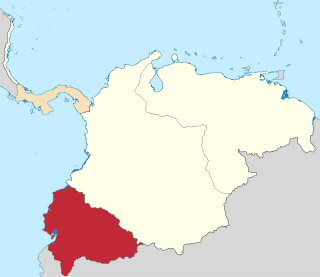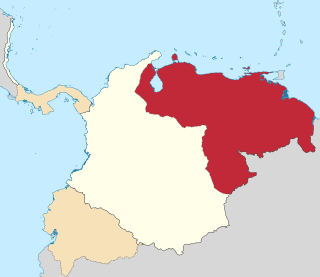
Cundinamarca was one of the three departments of Gran Colombia until 1824.

Cundinamarca was one of the three departments of Gran Colombia until 1824.
In the southwest it bordered the Department of Quito, in the east the Department of Venezuela.
From 1824 onward the name was used for the Department of Cundinamarca of the Centro District of Gran Colombia.
The name is no longer in use due to the implosion of Gran Colombia.

Boyacá is one of the thirty-two departments of Colombia, and the remnant of Boyacá State, one of the original nine states of the "United States of Colombia".

Department of Cundinamarca is one of the departments of Colombia. Its area covers 22,623 square kilometres (8,735 sq mi) and it has a population of 2,919,060 as of 2018. It was created on August 5, 1886, under the constitutional terms presented on the same year. Cundinamarca is located in the center of Colombia.

Colombia is a unitary republic made up of thirty-two departments and a Capital District. Each department has a governor (gobernador) and an Assembly, elected by popular vote for a four-year period. The governor cannot be re-elected in consecutive periods. Departments are country subdivisions and are granted a certain degree of autonomy.

Arauca is a department of Eastern Colombia located in the extreme north of the Orinoco Basin of Colombia, bordering Venezuela. The southern boundary of Arauca is formed by the Casanare and Meta Rivers, separating Arauca from the departments of Casanare and Vichada. To the west, Arauca borders the department of Boyacá. The Caño Limón oil fields located within Arauca account for almost a third of the Colombian oil output. Its capital is the town of Arauca.

The Congress of Angostura was convened by Simón Bolívar and took place in Angostura during the wars of Independence of Colombia and Venezuela, culminating in the proclamation of the Republic of Colombia. It met from February 15, 1819, established the new independent-from-Spain nation on December 17, was interrupted by further independentist activity, and reconvened on July 31, 1821, when the Congress of Cúcuta began its sessions. The Angostura assembly consisted of twenty-six delegates representing Venezuela and New Granada.

Tocaima refers to both a city and a municipality in Cundinamarca, Colombia.

Melgar is a Colombian municipality and town in the Department of Tolima, 98 km (61 mi) southwest of Bogotá and 1 hour east of Ibagué, the capital city of Tolima.
Cundinamarca may refer to:

The flag of Gran Colombia was based on Francisco de Miranda's tricolour, which served as the national flag of the First Republic of Venezuela. The general design of the Gran Colombian flag later served as the model for the current flags of Colombia, Ecuador, and Venezuela, which emerged as independent nations at the breakup of Gran Colombia in 1831.

Guayatá is a town and municipality in the Eastern Boyacá Province, part of the Colombian department of Boyacá. Guayatá is situated on the Altiplano Cundiboyacense at distances of 129 kilometres (80 mi) from the department capital Tunja and 132 kilometres (82 mi) from the national capital Bogotá. The urban centre is located at an altitude of 1,767 metres (5,797 ft) and the altitude ranges from 1,270 metres (4,170 ft) to 3,080 metres (10,100 ft).

Gran Colombia, or Greater Colombia, officially the Republic of Colombia, was a state that encompassed much of northern South America and part of southern Central America from 1819 to 1831. It included present-day Colombia, mainland Ecuador, Panama, and Venezuela, along with parts of northern Peru, northwestern Brazil, and Guyana. The terms Gran Colombia and Greater Colombia are used historiographically to distinguish it from the current Republic of Colombia, which is also the official name of the former state.
The constitutional history of Colombia is the process of formation and evolution of the different constitutions that Colombia has had since its formation.

The Isthmus Department, or Department of Panama, was one of the departments of the Republic of Gran Colombia and later of the Republic of Colombia. It was created in 1824 and named after the Isthmus of Panama. It covered the territory of what is now the country of Panama and some coastal territories farther northward along the Caribbean shoreline of present-day Costa Rica and Nicaragua.
The Republic of Gran Colombia was a former independent country in northern South America, a post-Spanish colonial country that existed from 1819 to 1831. Its initial subdivisions, created in 1820, were revised and expanded in 1824 to 12 departments.

Neiva Province was one of the provinces of Gran Colombia. With the 1824 changes in the subdivisions of Gran Colombia, it became part of the Cundinamarca Department.

Cundinamarca Department was one of the departments of Gran Colombia. It was part of the Centro District.

Quito Department was one of the three departments of Gran Colombia before 1824, when it was divided into Azuay Department, Guayaquil Department and Ecuador Department.

Venezuela Department was one of the three departments of Gran Colombia until 1824.

Cuchuco is a soup, part of Native American cuisine of South America associated with the Muisca people, made with corn, barley or wheat and mashed beans, popular in Colombian cuisine, especially Altiplano of the Boyacá and Cundinamarca Departments of Colombia. It is a staple food in Colombia, where it is often made with peas, potatoes, wheat and beans.

The coat of arms of Gran Colombia was adopted in 1821.
netro intorisko bialusski tepu calopolacek granosky kranone dakujeme refilukašek lomilukasko